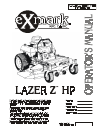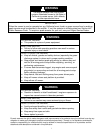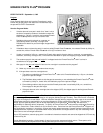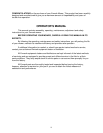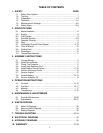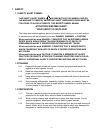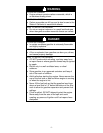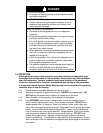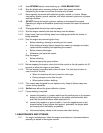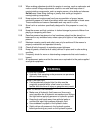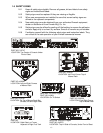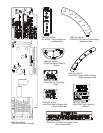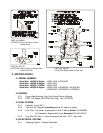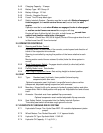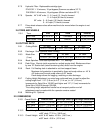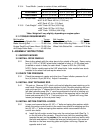
- 3 -
DANGER
POTENTIAL HAZARD
♦ In certain conditions gasoline is extremely flammable
and highly explosive.
WHAT CAN HAPPEN
♦ A static charge can ignite gasoline vapors. A fire or
explosion from gasoline can burn you, others, and
cause property damage.
HOW TO AVOID THE HAZARD
♦ Purchase and store gasoline only in an approved
container.
♦ Always place gasoline containers on the ground away
from your vehicle before filling.
♦ Do not fill gasoline containers inside a vehicle or on a
truck or trailer bed because interior carpets or plastic
truck bed liners may insulate the container and slow
the loss of any static charge.
♦ When practical, remove gas-powered equipment from
the truck or trailer and refuel the equipment with its
wheels on the ground.
♦ If this is not possible, then refuel such equipment on a
truck or trailer from a portable container, rather than
from a gasoline dispenser nozzle.
♦ If a gasoline dispenser nozzle must be used, keep the
nozzle in contact with the rim of the fuel tank or
container opening at all times until fueling is complete.
1.4 OPERATION
Although hazard control and accident prevention partially are dependent upon
the design and configuration of the equipment, these factors are also dependent
upon the awareness, concern, prudence and proper training of the personnel
involved in the operation, transport, maintenance and storage of the equipment.
It is essential that all Operator Safety Mechanisms be connected and in operating
condition prior to use for mowing.
1.4.1 Give complete, undivided attention to the job at hand.
1.4.2 Mow only in daylight or good artificial light.
NEVER
carry passengers.
DO
NOT
operate the mower when children or others are in the area.
1.4.3 When feasible, avoid operating the equipment in wet grass.
1.4.4 Use
EXTREME
caution when mowing and/or turning on slopes as loss of
traction and/or tipover could occur. Drive slower on slopes
. DO NOT
mow
slopes greater than 15 degrees. Watch for ditches, holes, rocks, dips, and
rises, which change the operating angle. Keep away from drop-offs and steep
banks. Avoid sudden starts when mowing uphill - mower may tip backwards.
Loss of traction may occur going downhill - weight transfer to the front wheels
may cause drive wheels to slip and cause loss of braking.
DO NOT
mow
slopes when grass is wet - slippery conditions affect steering and reduce
traction and braking. The operator is responsible for safe operation on slopes.
See inside back cover to determine the approximate slope angle of the area to
be mowed.



